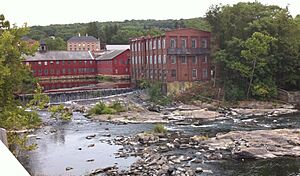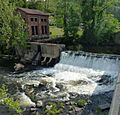Collinsville, Connecticut facts for kids
Quick facts for kids |
|
|
Collinsville Historic District
|
|
| Location | CT 179, Collinsville, Connecticut |
|---|---|
| Architect | Collins Co. |
| Architectural style | Greek Revival, Italianate, Romanesque |
| NRHP reference No. | 76001994 |
| Added to NRHP | June 23, 1976 |
Collinsville is a cool village and a census-designated place (CDP) in the town of Canton, Connecticut. It's located in Hartford County. In 2010, about 3,746 people lived here. The main part of the village is so special that it's listed as a historic district on the National Register of Historic Places.
This village was built around the Collins Company Axe Factory. This factory made super useful tools like axes, machetes, picks, and knives. Collins machetes were a favorite in South America. Their tools were used for big projects, like building the Trans-Siberian Railway. Axes and picks from Collinsville even helped people during the California Gold Rush. Plus, Admiral Peary carried Collins tools all the way to the North Pole!
Like many old factories in New England, the Collins Company axe factory was built right on the Farmington River. They used the river's power to run their machines and make tools. The old factory buildings are still there today. They are now rented out to different local businesses. Main Street in Collinsville still looks like it did a long time ago, with beautiful old buildings from the early 1900s.
Contents
History of Collinsville
Collinsville has a really interesting past!
Important Inventions
A historian named Diana Muir wrote that Elisha Root invented a super important industrial technique called die casting right here in Collinsville. Root worked for Samuel W. Collins, whose Collins Company was the biggest axe maker in the 1800s. Other famous people who lived in Collinsville included George Washington Flint and William E. Simonds.
Fun Events and Recognition
Collinsville hosts a fun Halloween Parade every year through its historic town. It's held on the last Saturday of October at 7 p.m. Before the parade, there are special activities for kids starting at 6 p.m.
In September 2007, Arthur Frommer's Budget Travel magazine voted Collinsville one of the "Top 10 Coolest Small Towns in America." That's pretty awesome!
Exploring Collinsville's Sites

Collinsville is right on the Farmington River. It's a popular spot for people to walk and bike because it's located along the Rails to Trails path. There are many cool places to visit in the town center.
Canton Historical Museum
The Canton Historical Museum is located in an old Collins Company factory building from 1865. This building was first used to finish and put together farm plows. Later, in 1924, it became a fun place for employees to relax. A man named Fred Widen, who made patterns for the company, used part of the building for his huge collection of Collins Company items.
Today, the Canton Historical Society owns this big building. It has a large collection of Collins Tools. You can also see many Victorian items, a general store from the past, old farm equipment, children's toys, and even wedding dresses worn by Canton residents from the late 1800s. They also have old music boxes, a large fire engine used by the Collins Company, and old phonographs. Upstairs, the Farmington Valley Railroad Society has a cool model train display of Collinsville from the early 1900s.
The museum also has a library with thousands of old papers and photos about Canton and Collinsville's history. You can even find black and white photos of the big flood in 1955. The museum has three floors, but they are working to make it easier for everyone to visit.
The Spite House
In the 1800s, a butcher in Collinsville had a disagreement with his neighbor. To get back at his neighbor, the butcher built a very narrow, two-story building between their houses. This building, located between 23 and 25 River Street, was only as wide as a normal stairway. It had windows with Venetian blinds. This way, the butcher could block the sun from his neighbor's home and block their view of his property whenever he wanted! This kind of building is called a spite house. Eventually, the butcher's son got along with the family next door and tore down the Collinsville Spite House.
Images for kids
See also
 In Spanish: Collinsville (Connecticut) para niños
In Spanish: Collinsville (Connecticut) para niños

















